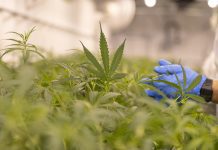
According to research by Oxford University, older adults are the fastest growing demographic of Canadian cannabis users.
The implications, however, of medical cannabis use for older adults are largely unknown. Despite this, there are a number of suggested mechanisms for this increase, including greater medicinal use and decreasing stigma associated with usage.
Since 2001, medical cannabis use has been legal in Canada and on October 17, 2018 the Cannabis Act was implemented, legalising recreational use nationwide. Under these new laws, anyone aged 18 or over can legally possess up to 30 grams of cannabis, purchase dried or fresh cannabis and cannabis oil from provincially-licensed retailers, grow up to four cannabis plants per residence for personal use, and/or make cannabis products, such as food and drinks.
Beyond these limits, though, individuals can still face jail time for illegal distribution, crossing borders, and a variety of other offences. However, the hope is that legalisation will keep individuals who consume cannabis out of the criminal justice system, reducing the burden on the legal system and saving taxpayers’ money.
Impact on health care
Whilst legalisation may keep legal system spending down, it is not yet known what effect (if any) increasing medical cannabis use will have on the health system, particularly with respect to older adults.
The majority of evidence for the health effects — both positive and negative — of medical cannabis use has largely been conducted with younger sample groups. Early findings suggest that for individuals that take up smoking cannabis at an early age, there are a host of negative mental health effects, notably depression, anxiety and suicidality, associated with this behaviour.
It has been suggested that in adolescent brains, which are still under development, taking psychotropic drugs — such as those containing tetrahydrocannabinol (THC), the psychotropic compound in cannabis — may impact neurological development.
Given that many older adults experience cognitive impairment, the interaction between the psychotropic effects of THC are an important area of future investigation. It is also unclear what the implications are of taking other pharmaceutical drugs alongside cannabis.
On the other end of the spectrum, though, the use of cannabidiol (CBD), which is a non-psychotropic compound found in cannabis, has been recommended for a variety of physical ailments experienced by older adults, such as chronic pain.
In rat models, CBD has shown promise as a form of pain relief that does not have the negative side effects of alternative forms of analgesia, particularly opioids. However, the efficacy of CBD in human trials, particularly with older adults is scant.
Older patients
The knowledge surrounding the positive and negative effects of cannabis use is limited, as is the knowledge that older adults have on the subject. To date, there are no established guidelines for the use of cannabis for older adults.
In response to this, the Canadian Coalition for Seniors’ Mental Health has set about to develop usage guidelines to aid clinicians in advising older adults. Concerns raised by the Coalition include drug interactions, implications for increased confusion, the risk of falls due to loss of balance, and potential mental health effects.
Making the issue even more complex is the increasing potency of cannabis in the last several decades. For older adults who may have used cannabis in the 60s or 70s, the levels of THC in modern cannabis strains may be several orders of magnitude more potent. Consequently, increasing the cannabis literacy of older adults is critical to the safe and appropriate usage of cannabis products.
With an increasing number of older adults using cannabis products, it is imperative that more information be collected and disseminated. Although cannabis may be legal, this does not necessarily mean that it is safe in all circumstances. Studies looking at younger adults have identified mental health risks, which have not been explored to the same degree amongst older adults.
Although there is emerging evidence for positive effects of cannabis on age-related physical ailments, these data are far from conclusive and it is uncertain as to whether the negative effects outweigh the positive ones. Whilst guidelines are being developed it is important to be measured in the use of cannabis, particularly for older adults who may have be more vulnerable than others.


















